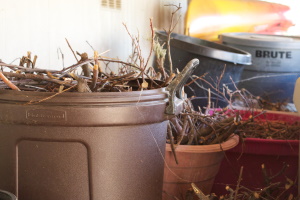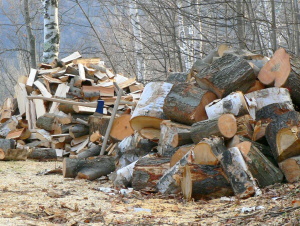2 Great Ideas on How to Store Kindling
Kindling wood is the crucial element of a successful burn – if you have none, good luck lightning those firewood pieces of yours.
Because it is essentially small twigs and sticks, it can be very hard to manage if you don’t figure out how to store all that.
Leave it be with the firewood stack
One of the better looking ways of storing your fire kindling is by stacking it alongside the regular cordwood.

Image by Mark Buckawicki via Wikimedia Commons
For example, if you end up building some supports in a criss-cross pattern with the firewood, the openings which are left off can easily be filled with the kindling sticks (Image 1).
Because everything is left like that out in the open, the kindling will not only dry quicker, but also stay so for a longer time.
This is the only no-cost, basic solution to the storage problem i am tackling on this article.
Stack in a container

Image by Alan Levine via Flickr
The classic method of storing kindling is by simply utilizing some sort of a bin, basket or can to get it done (Image 2).
You can even go as far as piling the sticks to the top, then stacking the containers on top of one another, to maximize the storage potential.
The only real con of these ideas is that the twigs, sticks or anything you will use as kindling, won’t be able to season, in other words, dry as properly.
Obviously that is because the content inside won’t be as exposed to the elements. That’s all really.
It goes without saying that you should not leave kindling, or any sort of firewood-fuel material, inside your living home.
I know it looks cute and all, most importantly is convenient, but doing so you risk bringing in bugs and things of that nature; that is only a no-no.
I go as far as bringing inside as much wood as i need for the time being, and when i have to start up a new fire, i go outside to the stack and repeat it all again.
Sure, it is uncomfortable to get out early in the morning just to get enough firewood to fire up the ol’ burner, but that’s what i have to do in order to not have to deal with all the bug-related nuisance.
How to make kindling (without spending extra time)
When homeowners think about getting kindling, I’d assume most of them think about taking the firewood they got, and going to work at it with an axe, to make the suitable pieces.
But what if i told you that you may just not need to do anything like that?
One day worth of firewood round splitting can produce enough kindling to last you months and months!

Image by dvs via Flickr
Inspect the ground after you’ve done processing the wood for the day – all those scrap pieces of bark and wood you see make amazing kindling, that’s it (Image 3).
Collect a handful every now and then, and you’ll never need to make more time for something that is already a pain to do (for some).
Maybe forgo the kindling to begin with?
Here’s the deal – dealing with kindling, when you already had to go through so many hoops just on the firewood itself, can be a chore to some (not me personally).
If that’s the case for you, use fire starters instead. A pack of these cedar ones can last you for a looong time (affiliate link to Amazon).
Just break off a smaller piece, and use that as the go-to kindling source. You’d be surprised how easy they light up and burn!
I like your sense of humor and the way you talk! When I read your bio I thought, “Yep. He seems like a cool country guy.” Thanks for the concise info!
Hi Julius, I’m trying to find a way to use the whole tree for firewood. I run a woodstove and wood fired oven so I need all sizes of wood. Currently I’m stacking the branches on a trailer looping chains around them and pulling tight. Plan to run the chainsaw through the bunches. Storing all that kindling is the next question! Probably a small layer between the firewood layers in the shed is the best idea – thanks for the tip!
My pleasure 🙂